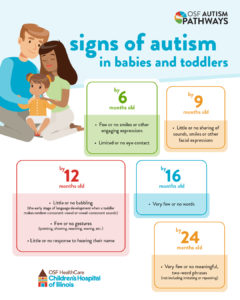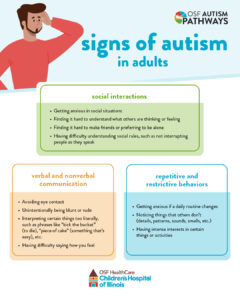
What is autism?
Autism spectrum disorder (ASD) is a neurological and developmental disorder that affects the brain and impacts how people interact, communicate and behave. According to the Centers for Disease Control and Prevention (CDC), one in 36 children has ASD, and boys are nearly four times more likely to be diagnosed than girls.
Not everyone who has autism displays the same characteristics or abilities. That’s why this disorder is called a spectrum. But the common feature for each person on the spectrum is a diagnosis of some kind of social, communication or behavioral challenge.
Signs of autism
“Autism is easier to diagnose today than it was 10 or 20 years ago because there is a lot more we know about it,” said Theresa Regan, PhD, a neuropsychologist at OSF HealthCare. “However, families and primary care physicians need to be aware of the signs so that children get referred for diagnosis.”
ASD isn’t usually diagnosed until a child is 2 years old or older, but signs can often be seen between 9 and 12 months of age.
Signs of autism in babies
By 6 months old
- Few or no smiles or other engaging expressions
- Limited or no eye contact
By 9 months old
- Little or no sharing of sounds, smiles or other facial expressions
Signs of autism in toddlers
By 1 year old
- Little or no babbling (the early stage of language development when a toddler makes random consonant-vowel or vowel-consonant sounds)
- Few or no gestures (pointing, showing, reaching, waving, etc.)
- Little or no response to hearing their name
By 16 months old
- Very few or no words
By 2 years old
- Very few or no meaningful, two-word phrases (not including imitating or repeating)
Additional behavioral signs in children
As children get a little older, there are other behavioral signs of autism that parents can be on the lookout for. One of them is when a child doesn’t develop typical play skills but tends to migrate toward repetitive things and routine. For example, instead of rolling a toy car along the ground, a child might turn the car over and enjoy watching the wheels spin for long periods of time.
“Another behavior, although rare, is something called pathological demand avoidance, or PDA,” Dr. Regan said. “While all children will occasionally resist being told what to do, kids with PDA take this resistance to an extreme, irrational level that can vary from day to day.
“With PDA, it’s less about the characteristics of a demand than it is about having a demand placed. The demand increases anxiety to an extent that a child becomes resistant. This includes things a child finds easy or even enjoys, such as using the bathroom before bedtime or looking at a picture book. Even praise from an adult can induce anxiety because it implies a demand to replicate the behavior in the future.”
However, autism may not be apparent until later in childhood as the demands of life begin to increase.
“It’s possible for a child with autism to do well with being nice and playing well with others when they’re young, but when they get to an age when navigating social relationships isn’t so straightforward, they can begin to have difficulty,” Dr. Regan said. “This can be revealed by the increased demands for flexibility, independence and communication in middle school and high school. It can also become apparent during adulthood despite being present since a person’s early developmental period.”
Signs of autism in adults
Social interactions
- Getting anxious in social situations
- Finding it hard to understand what others are thinking or feeling
- Finding it hard to make friends or preferring to be alone
- Having difficulty understanding social rules, such as not interrupting people as they speak
Verbal and nonverbal communication
- Avoiding eye contact
- Unintentionally being blunt or rude
- Interpreting certain things too literally, such as phrases like “kick the bucket” (to die), “piece of cake” (something that’s easy), etc.
- Having difficulty saying how you feel
Repetitive and restrictive behaviors
- Getting anxious if a daily routine changes
- Noticing things that others don’t (details, patterns, sounds, smells, etc.)
- Having intense interests in certain things or activities
Autism masking
It can be hard to recognize autism because of something called masking. Masking happens when a person with autism tries to fit in better by hiding their autistic traits and copying the behaviors of people who don’t have autism. This happens a lot in certain groups of people, like those who have milder autism, girls and teenagers.
“Some kids with autism may not even realize they’re masking. But they know that certain behaviors aren’t accepted, so they try not to do them,” Dr. Regan said. “For example, we often tell kids to follow rules, such as being polite, standing quietly in line, etc., and kids may follow these rules to gain our approval.”
Need an autism diagnosis or support?
As kids get older and become adults, they may start to realize that some of the things they do are connected to autism. So, they might try to change those behaviors to meet what other people expect from them. This can include actions like:
- Trying to be less blunt
- Copying the facial expressions of others
- Forcing eye contact during conversations
- Asking more questions than they would normally be comfortable asking
- Reducing sensory reactions, such as trying not to flinch when someone touches them even if they’re sensitive to touch
Autism treatment
Because ASD varies from person to person, no two autism therapy treatment plans are exactly alike. Each one is different and individualized based on a person’s age, needs, goals and cognitive level. However, the most successful treatment programs are those that start as early as possible.
Types of therapies:
- Occupational therapy: Can help improve cognitive, physical, social and motor skills
- Speech therapy: Can help improve verbal, nonverbal and social communication skills
- Applied behavior analysis therapy: Focuses on increasing positive behaviors by rewarding those behaviors
- Appropriate school setting: Schools that are designed to meet the specific needs of children with autism
- Medication: Used for treating certain symptoms of ASD, such as irritability and problem behaviors
“Getting children in the right environment to learn those social and play skills they haven’t naturally acquired is important,” Dr. Regan said. “So, the earlier we can come alongside children and their families to provide the necessary therapy, the better these children will be able to interact, communicate and function as they grow into adulthood.”
Is autism genetic?
There has been a lot of speculation about what causes autism, and it’s still not 100% clear. However, there is a strong link to the genes a person is born with.
“Some studies have shown that at least 80% of autism triggers are genetic,” Dr. Regan said. “But at the same time, not everyone with the same genetic differences also displays the same characteristics of autism. In these cases, environmental factors can be part of the root cause, such as exposure to toxins or infections before or after birth.”
Awareness – and beyond
Public awareness of autism continues to increase thanks to the advocacy of countless organizations and individuals as well as things like Autism Acceptance Month in April. And while that’s a very good thing, it’s also necessary to be sensitive and accepting of all those impacted by autism.
“It can be difficult to put ourselves in someone else’s shoes to understand their life experience with autism,” Dr. Regan said. “But, even so, we can always take time to recognize their journey, be inclusive and help them get the opportunities and support they need.”

